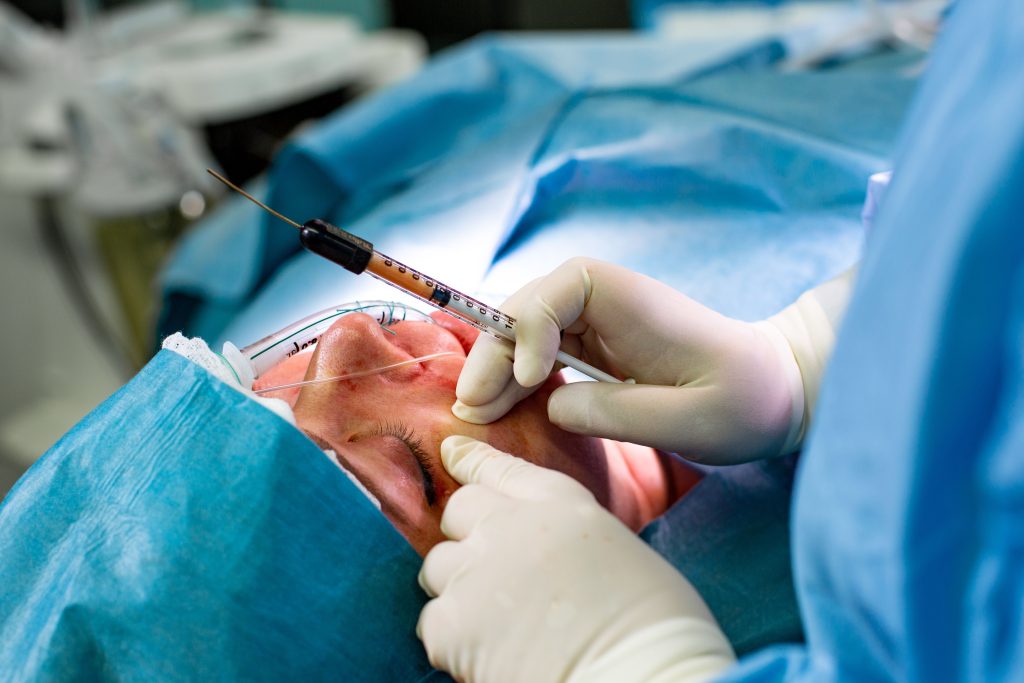Facial rejuvenation with fat transfer offers a fresh approach to enhancing your appearance. This innovative technique uses your body’s own fat to restore volume and smooth out wrinkles. It’s not just about looking younger with techniques like stem cell facelift; it’s about feeling confident in your skin through facial augmentation, facial volume restoration, and facial fat grafting.
Fat transfer can target areas like the cheeks, under the eyes, and lips, creating a natural look that fillers often can’t achieve. The procedure is minimally invasive and provides long-lasting results, making it a popular choice for many. With the right expertise in facial augmentation, you can achieve a youthful glow without the need for synthetic products through autologous fat grafting or other fat grafting procedures like facial fat grafting. Discover how this method can transform your face and boost your self-esteem.
Key Takeaways
-
Facial fat transfer is a natural way to rejuvenate your appearance by using your own fat, making it a safe option for many.
-
The benefits of fat grafting include improved skin texture, volume restoration, and a more youthful look without synthetic fillers.
-
Ideal candidates are those with sufficient fat deposits and realistic expectations about the results; consult with a qualified professional to determine your suitability.
-
Proper preparation for the procedure includes following pre-operative instructions and discussing any medical conditions with your doctor.
-
Recovery involves managing swelling and bruising, so follow aftercare tips closely for the best results and a smooth healing process.
-
Be aware of potential risks, such as infection or uneven results, and discuss these with your surgeon to make an informed decision.
Understanding Facial Fat Transfer
Harvesting Fat
Fat transfer begins with harvesting fat from a donor site. Common areas for fat removal include the abdomen and thighs. A surgeon uses liposuction to extract the fat. This involves inserting a thin tube called a cannula into the skin during facial fat grafting, which may lead to fat grafting complications. The surgeon then gently removes the fat through suction.
After harvesting, the fat undergoes processing. This step removes impurities and prepares it for injection. The purified fat is placed in syringes, ready for transfer to the face.
Targeted Areas
Facial fat transfer focuses on specific areas of the face. These areas often show signs of aging or volume loss. Common targets include:
-
Cheeks
-
Temples
-
Nasolabial folds
-
Under-eye area
-
Jawline
Injecting fat into these regions restores facial volume and improves overall appearance. Surgeons customize treatment based on individual needs.
Age-Related Volume Loss
As people age, they experience natural volume loss in their faces. This occurs due to decreased fat and collagen production. The skin becomes thinner, leading to sagging and wrinkles. Fat transfer serves as an effective solution for this issue.
The procedure enhances facial contours by filling in hollow areas. It can also improve skin texture and elasticity. Many patients report a more youthful look after the procedure.
Fat transfer plays a vital role in facial rejuvenation cases. It provides a natural alternative to synthetic fillers and implants. Patients often prefer using their own fat, reducing the risk of allergic reactions.
Surgeons perform facial augmentation procedures with care. They assess each patient’s unique structure before proceeding. This ensures optimal results and a balanced appearance.
Overall, facial fat transfer is a versatile technique in cosmetic surgery. It offers significant benefits for those seeking to restore lost volume and achieve a youthful look.
Benefits of Fat Grafting
Natural Results
Fat grafting offers natural-looking results. This procedure uses the patient’s own fat, which reduces the risk of rejection. The body accepts its own tissue better than foreign materials. Patients often report a more youthful and refreshed appearance after treatment.
The use of regenerative fat grafting enhances these outcomes. It promotes tissue regeneration in the treated areas. This leads to improved skin texture and volume. Patients notice smoother contours and reduced wrinkles.
Dual Benefit
Fat grafting provides a dual benefit. The process begins with liposuction to remove fat from another area of the body. Common donor sites include the abdomen, thighs, or hips. This not only contours the body but also supplies fat for facial rejuvenation.
By removing excess fat, patients achieve a slimmer profile while enhancing their facial features. The combination makes this procedure appealing to many individuals seeking both body shaping and facial enhancement.
Improved Fat Survival
Adding Platelet-Rich Plasma (PRP) can improve fat survival rates. PRP contains growth factors that aid healing and tissue regeneration. When combined with fat injections, it creates a supportive environment for the transferred fat cells.
Patients may experience longer-lasting results due to this combination. Studies show that using PRP alongside facial fat grafting increases the chances of successful integration of grafted fat.
Safety Profile
While there are some fat grafting complications, they are generally minimal when performed by experienced surgeons. Possible risks include infection or uneven results, but these are rare. Proper technique and patient selection reduce these risks significantly.
Surgeons assess each individual for suitability before the procedure. They consider factors such as health history and skin quality. This careful evaluation helps ensure safe outcomes.
Versatility
Fat injections offer versatility in treatment options. They can be used to fill hollows under the eyes, enhance cheeks, or improve lip volume. Each application targets specific areas for rejuvenation.
Patients appreciate this flexibility as it allows for customized treatment plans. Surgeons can tailor procedures to meet individual aesthetic goals effectively.
Ideal Candidates for Fat Transfer
Volume Loss
Individuals often experience facial volume loss as they age. This can lead to a tired or sunken appearance. The cheeks may flatten, and the skin may sag. Such changes can be distressing. Many seek solutions to restore their youthful look. Fat transfer treatment offers an effective option.
Natural Alternative
Candidates typically want a natural alternative to synthetic fillers. While fillers provide immediate results, they are temporary. They require regular maintenance. Fat transfer provides longer-lasting results since it uses the patient’s own fat. This method minimizes the risk of allergic reactions. Patients appreciate the more natural look that comes from using autologous fat.
Sufficient Donor Fat
Suitability for fat transfer also depends on having sufficient donor fat. Candidates need adequate adipose tissue in areas like the abdomen or thighs. Liposuction is used to harvest this fat tissue. During this process, doctors remove excess fat from these areas. After harvesting, the fat undergoes processing before injection into the face.
Age Considerations
Age plays a role in determining candidates for this procedure. Older adults often benefit more from fat transfers due to significant volume loss. Younger individuals may also seek this treatment but usually have different motivations. They might want to enhance specific facial features rather than address aging signs.

Health Factors
Health status is crucial when considering fat transfer. Candidates should be in good overall health without serious medical conditions. Those with conditions that affect healing may not be suitable for this procedure. A thorough consultation with a qualified surgeon helps assess individual health risks.
Realistic Expectations
Candidates must have realistic expectations about fat transfer results. Results vary based on individual factors like metabolism and lifestyle choices. Some may require multiple sessions for optimal outcomes. Understanding these aspects helps ensure satisfaction with the final appearance.
Emotional Readiness
Emotional readiness is another important factor. Individuals must be mentally prepared for the changes that come with facial rejuvenation. Support from family and friends can help during the recovery period.
Preparing for the Procedure
Pre-Consultation
Consultations are essential before any facial rejuvenation procedure. A qualified doctor will assess your facial structure and identify suitable donor sites for fat transfer. This step ensures that the injection of fat will improve volume in the desired areas. The doctor will discuss your goals and expectations during this meeting.
Understanding your unique anatomy helps in creating a personalized treatment plan. Measurements and photographs may be taken to track progress later. It is important to share your medical history, including any previous surgeries or skin conditions.
Lifestyle Changes
Making lifestyle changes can significantly impact recovery. Smoking should be ceased at least two weeks prior to the procedure. Nicotine constricts blood vessels, which can hinder healing. Certain medications, such as blood thinners and anti-inflammatory drugs, must also be avoided. These drugs increase bleeding risks during surgery.
Your doctor will provide a list of medications to discontinue. Following these recommendations can lead to better outcomes after the fat transfer.
Post-Care Arrangements
Planning for post-procedure care is crucial for a smooth recovery. Arrange for someone to drive you home after the surgery. You may feel groggy or disoriented due to anesthesia. Having support will help during your initial recovery phase.
Prepare your home for rest and relaxation post-surgery. Stock up on supplies like ice packs, comfortable pillows, and over-the-counter pain relief medication. Follow all post-operative instructions provided by your surgeon carefully.
Understanding Fat Transfer
Fat transfer involves using your body’s own fat as a filler. This technique restores volume to areas of the face that have lost fullness over time. The process includes harvesting fat from donor sites, usually the abdomen or thighs, through liposuction.
The harvested fat is then processed and injected into specific facial areas. This method provides natural-looking results since it uses your body’s own material. Patients often appreciate the dual benefit of contouring their bodies while enhancing their faces.
Realistic Expectations
Setting realistic expectations is vital before undergoing facial rejuvenation with fat transfer. Results may take time to fully develop as swelling subsides and the fat settles into place. Understanding that some fat may be reabsorbed by the body is also important.
Discuss these factors with your doctor during consultations. They can provide insights based on previous patients’ experiences and outcomes.
Techniques in Fat Grafting
Liposuction Steps
The fat grafting procedure begins with liposuction. This removes excess fat from areas like the abdomen or thighs. Surgeons use a thin tube called a cannula to extract the fat. They make small incisions for this process.
Next, they collect the fat in sterile containers. The amount of fat removed varies based on the patient’s needs. After extraction, they prepare the fat for transfer.
Fat Purification Process
Purification is crucial in the fat grafting process. It helps ensure that only healthy fat cells are used. Surgeons often use centrifugation or filtration methods. These techniques separate viable fat from blood and oil.
Centrifugation spins the fat at high speeds. This separates components effectively. Filtration uses gravity to allow unwanted substances to settle out. Both methods enhance the quality of fat grafts.
Precise Injection Techniques
Injecting purified fat requires skill. Surgeons use special syringes and needles for precision. They inject small amounts of fat into specific layers of tissue. This technique promotes better integration with surrounding tissues.
Proper injection depth is vital for successful graft uptake. Injecting too superficially can lead to uneven results. Surgeons must also consider the area being treated, such as the cheeks or lips.
Importance of Technique
Technique plays a significant role in maximizing fat retention. Studies show that proper handling during extraction and injection increases survival rates of fat cells. Using gentle suction during liposuction minimizes trauma to the cells.
Surgeons focus on creating a natural contour while ensuring adequate volume. This approach helps maintain the desired look over time.
Advancements in Technology
Recent advancements have improved fat grafting technology. Micro-fat grafting is one such technique. It involves using smaller droplets of fat for delicate areas like around the eyes or lips.
This method allows for smoother results and less risk of lumpiness. Surgeons can achieve subtler changes with micro-fat grafting. Patients benefit from more natural-looking enhancements.
Case Examples
Numerous successful fat grafting cases demonstrate these techniques’ effectiveness. Patients report satisfaction with their enhanced appearance after lip augmentation or facial rejuvenation.
The combination of advanced techniques and careful execution leads to lasting results. Many individuals choose this method due to its natural origins and minimal downtime.
Recovery and Aftercare Tips
Compression Bandages
Wearing compression bandages after facial rejuvenation is crucial. These bandages help reduce swelling and support the healing process. They apply gentle pressure to the treated areas. This pressure prevents fluid buildup and promotes better blood circulation.
Patients should wear these bandages as directed by their surgeon. Typically, they need to be worn for at least a week post-surgery. Following instructions carefully can lead to better outcomes. Removing the bandages too soon can increase the risk of complications.
Managing Swelling and Bruising
Swelling and bruising are common after fat transfer procedures. Patients can manage these symptoms effectively with medications. Over-the-counter pain relievers such as ibuprofen can help reduce discomfort. Ice packs can also be beneficial. Applying ice for 15-20 minutes every hour during the first few days can minimize swelling.
Doctors often prescribe specific medications to help with bruising and inflammation. It is essential to follow the prescribed dosage and schedule. Avoiding blood thinners, like aspirin, in the early recovery phase is crucial. These can worsen bruising and prolong recovery time.
Gradual Return to Activities
Returning to normal activities should happen gradually. Patients must listen to their bodies during this time. Light activities can begin within a few days, but strenuous exercise should wait longer. Most surgeons recommend avoiding intense workouts for at least two weeks.
Follow-up appointments are vital in this recovery phase. These allow doctors to monitor healing progress and address any concerns. Patients should attend all scheduled visits, even if they feel well. Regular check-ups ensure that everything is healing correctly.
Emotional Support
Recovery from facial rejuvenation can be emotional. Changes in appearance may cause anxiety or concern about results. Seeking support from friends or family can help ease these feelings. Open discussions about experiences can provide reassurance.
e patients may benefit from talking to a counselor or therapist during recovery. A professional can assist in managing emotional responses to physical changes.
Long-term Care
Long-term care is essential for maintaining results after fat transfer. Staying hydrated helps skin elasticity and overall health. A balanced diet rich in vitamins supports healing and rejuvenation.
Sunscreen use is critical after surgery as well. Protecting the skin from UV rays prevents damage and preserves results over time.
Potential Risks and Complications
Infection Risks
Infection is a common concern after any surgical procedure. Fat transfer involves removing fat from one area and injecting it into another. This process can introduce bacteria. If infection occurs, it may require antibiotics or additional surgery.
Patients should monitor for signs of infection. Symptoms include redness, swelling, or increased pain in the treated areas. Early detection is crucial for effective treatment.
Asymmetry Issues
Asymmetry can happen when the fat doesn’t distribute evenly. Some areas may appear fuller than others. This unevenness can affect the overall aesthetic outcome. Surgeons often aim to achieve balance, but results can vary.
Discussing expectations with your surgeon helps manage these concerns. They can provide insights on how to minimize asymmetry during the procedure.
Fat Resorption
Fat resorption refers to the body absorbing some of the injected fat. Not all transferred fat will survive in its new location. Studies show that about 30% to 50% of the transferred fat may be reabsorbed over time.
This means that patients might not achieve their desired volume after healing. Understanding this process is vital for setting realistic goals.
Rare Complications
While most complications are minor, some rare risks exist. These include embolism and nerve damage. An embolism occurs when fat enters the bloodstream and blocks a blood vessel. This situation can lead to serious health issues.
Nerve damage is also rare but possible. It may result from improper injection techniques or pressure on nerves during the procedure. Both conditions require immediate medical attention.
Importance of Communication
Before undergoing facial rejuvenation with fat transfer, patients must discuss risks with their surgeon. Open communication allows for a better understanding of potential complications. Surgeons can explain how they plan to minimize these risks during the procedure.
Patients should feel comfortable asking questions about their specific case. Understanding personal risk factors is essential for informed decision-making.
Surgeons often provide pre-operative assessments to identify any underlying issues that could increase risk. This includes evaluating medical history and current health status.
Long-Term Results and Expectations
Realistic Expectations
Results from facial rejuvenation with fat transfer can vary. Patients should set realistic expectations about how long the results will last. While some improvements are noticeable immediately, the final outcome may take several months to fully develop.
Fat transfer results are not permanent. Over time, the body may reabsorb some of the transferred fat. Studies show that about 30% to 50% of the injected fat may be absorbed within six months after the procedure. This means that patients might see a decrease in volume over time.
Touch-Ups Needed
Touch-ups may be necessary for maintaining desired results. Many people experience some fat loss after the initial transfer. If significant volume loss occurs, a follow-up procedure can help restore fullness. Regular consultations with a qualified practitioner can guide patients on when touch-ups might be needed.
Patients should also consider their lifestyle choices. Factors like weight fluctuations and aging can affect how long the results last. Maintaining a stable weight helps preserve facial contours. Healthy habits, such as regular exercise and balanced nutrition, also support lasting outcomes.
Long-Lasting Improvements
Facial contour improvements can be significant and long-lasting. Fat transfer enhances volume in areas like cheeks, temples, and around the mouth. This creates a more youthful appearance. The natural look of fat transfer is often preferred over synthetic fillers.
The benefits of fat transfer extend beyond aesthetics. Improved facial contours can boost confidence and self-esteem. Many individuals report feeling more attractive after the procedure. Emotional well-being is often linked to physical appearance.
Patients should also understand that individual results can differ based on various factors. Genetics, skin quality, and age all play a role in how well the body accepts the fat grafts. Some people may experience longer-lasting results than others.
Overall, facial rejuvenation with fat transfer offers promising enhancements in facial structure. With proper care and realistic expectations, many enjoy improved results for years to come.
Conclusiones
Facial rejuvenation with fat transfer offers a natural way to enhance your appearance. You gain volume, improve contours, and enjoy long-lasting results. Ideal candidates can expect a smoother, youthful look with minimal risks when properly informed and prepared. Understanding the process helps you navigate recovery and aftercare, ensuring the best outcomes.
If you’re considering this procedure, consult a qualified professional to discuss your goals. Explore how fat grafting can transform your look and boost your confidence. Take the next step toward revitalizing your appearance today!
Frequently Asked Questions
What is facial fat transfer?
Facial fat transfer, or fat grafting, involves removing fat from one area of the body and injecting it into the face. This procedure enhances volume, smooths wrinkles, and rejuvenates appearance.
How long do results last?
Results from facial fat transfer can last several years. Factors such as age, lifestyle, and skin quality influence longevity. Regular maintenance may enhance durability.
Is the procedure painful?
Most patients report minimal discomfort during facial fat transfer. Local anesthesia is used to ensure a pain-free experience. Post-procedure pain is typically manageable with over-the-counter medication.
How should I prepare for the procedure?
Preparation includes consulting your surgeon about medical history and medications. Avoid blood thinners and smoking at least two weeks prior to surgery for optimal healing.
What are the risks involved?
Potential risks include infection, uneven results, or fat reabsorption. Discuss these concerns with your surgeon to understand how they can be minimized.
How long does recovery take?
Recovery usually takes 1-2 weeks. Swelling and bruising may occur but generally subside quickly. Follow your surgeon’s aftercare instructions for best results.
Can anyone undergo fat transfer?
Ideal candidates are healthy adults with sufficient fat reserves and realistic expectations. A consultation with a qualified surgeon will determine individual suitability for the procedure.





